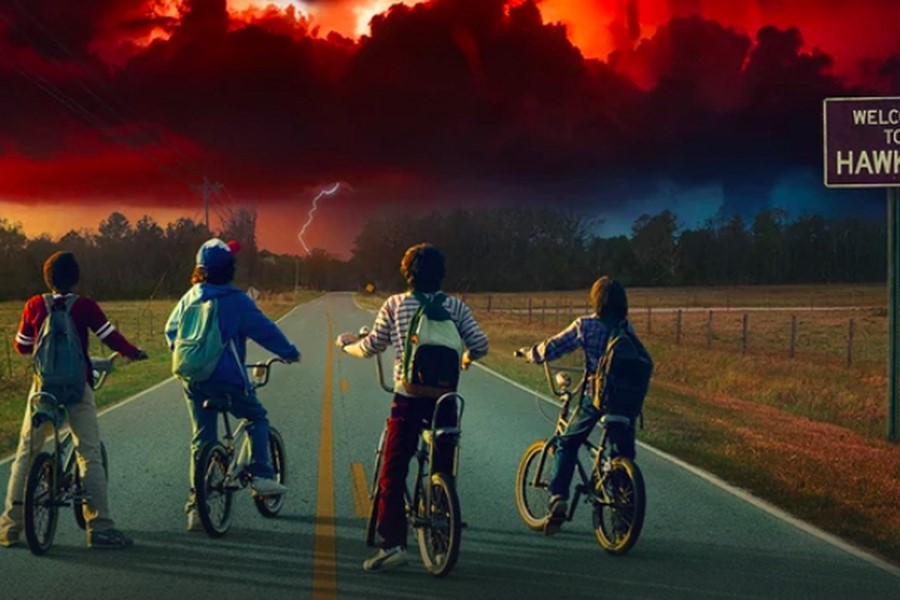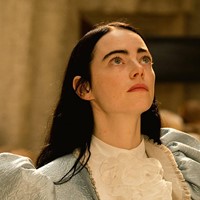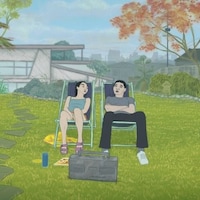SERIOUS SPOILERS IN HERE – DON’T READ IF YOU HAVEN’T SEEN IT YET
We’re back in the topsy-turvy town of Hawkins, Indiana, transported back to a 1980s nightmarescape which you both fear, yet also really want to live in. Stranger Things 2, the second instalment of Netflix’s hit show, has returned in all its binge-worthy, pop culture-heavy, nostalgic wonder, and after watching all nine episodes consecutively, I can say it does not disappoint. When its creators Matt and Ross Duffer announced their would be a sequel to their sci-fi cult series, lovers of the show were somewhat sceptical. How do you improve upon and develop a cultural phenomenon while staying true to its core makeup?
Well, if Stranger Things was an ode to Stephen King and the horror canon, Stranger Things 2 sits comfortably within it. The party - Mike, Dustin, Lucas and Will – is back together, but changed forever. Unlike the cosiness and familiarity of Hawkins in the first series, each central character grapples with the trauma of the past, and future, in a far more robust exploration of the human psyche. Stranger Things 2 isn’t simply a continuation of old storylines, but it is a fully-fledged stand alone sequel as worthy – if not more worthy – of analysis.
GOING DEEPER INTO DARKNESS
First of all, Stranger Things 2 is far more scary than the first series. Terror and fear of what’s bubbling just underneath the surface are used much more heavy-handedly. Although, like with the first series, there are moments of joy and humour, the new world of Hawkins is a hellish test of endurance. At the end of season one, Will Byers (Noah Shnapp) coughed up a slimy slug-like creature, signalling that his ordeal with the Upside Down is far from over. His body and mind becomes possessed by the ‘dark shadow’ throughout Stranger Things 2, presenting a psychologically traumatic portrait of evil in its true form. Shnapp’s frankly outstanding portrayal of Will is pivotal to the show’s turn towards horror, and his onscreen friends and family do a thoroughly convincing job of disturbed loved ones trying to find light within darkness.
No creators do pop culture references like the Duffer brothers, and Stranger Things 2 is a homage to all things horror. Its plot devices follow the same patterns of films like Blue Velvet and Halloween, where the decaying darkness of suburban America begins to inch above ground. The seemingly quiet, sleepy town of Hawkins, which could be almost anywhere in midtown America, has a twisted underbelly. As maverick journalist Murray Bauman (Brett Gelman) tells Nancy Wheeler (Natalia Dyer) and Jonathan Byers (Charlie Heaton): ‘People don’t spend their time looking behind the curtain. They like the curtain.’ Stranger Things 2’s aesthetic and the otherworldly creatures in the show also borrows heavily from Aliens. Any fans of James Cameron’s seminal sci-fi classic are bound to be happy with this series.
PAIN, SHARED TRAUMA AND RESISTANCE
What Stranger Things did so well was navigate between comfort and pain. Although bad things happened, viewers couldn’t wait to jump back into that ‘80s world of bad haircuts, disco tunes and kitschy decor. You always somehow knew everything would be alright. Stranger Things 2, however, creates a world where the ‘big bad’ has already happened, and everyone has to deal with it. The beginning episodes see Will’s therapy sessions where he is diagnosed with post traumatic dress disorder (PTSD). Joyce Byers (Winona Ryder) refuses to leave her son on his own, anxious and isolated about past ordeals. Eleven (Millie Bobby Brown) is back, suffering from flashbacks of being kidnapped at birth, experimented on, tormented by the laboratory. Jim Hopper (David Harbour) is now the self-designated protector of Eleven, restricting her movements for fear she will die like his daughter.
“If the world of Stranger Things was fighting against a misunderstood and strange evil, the world of Stranger Things 2 is learning to live within that danger and darkness”
If the world of Stranger Things was fighting against a misunderstood and strange evil, the world of Stranger Things 2 is learning to live within that danger and darkness. In many ways, the series is about resilience. Each character has their own psychological demons to battle, either alone or as a group, and the series makes an adequate stab at exploring mental health and trauma. Joyce, in particular, has journeyed the furthest from worrying mum to all-out fighter. She may have human reactions as any mother would, but her strong exterior is in stark contrast to the first series. Often in sci-fi and horror film and TV, pain is forgotten as soon as the monster is killed, but Stranger Things 2 is far more human in its depiction of personal trauma.

FRAILTY OF INNOCENCE
Most of the people watching Stranger Things and Stranger Things 2 won’t have lived through the ‘80s, or remember much if they did. It’s now hard to imagine a time when kids could ride their bikes in the streets, stay out all day and not be reported missing to the police, and perhaps most importantly, not be immediately contactable by smartphone. The kids of Stranger Things 2 illustrate those moments separating innocence and maturity. They have all seen terrifying things and fought them head-on; they devise clever plans to kill the bad guys; their emotional development is almost unbelievable for boys of their age.
But, at the same time, what the series does well is pull the audience back into focus with scenes of high school mundanity and tradition. Lucas Sinclair (Caleb McLaughlin) and Dustin Henderson (Gaten Matarazzo) fight for the affections of new classmate Max (Sadie Sink), Mike Wheeler (Finn Wolfhard) tries to contact Eleven via walkie-talkie every night, and the gang’s love of Dungeons and Dragons plays a central role throughout both series. It’s these moments of pubescent charm that gives the Stranger Things series its cultural longevity. At the same time as battling real-life demons, the party are battling the sometimes monstrous aspects of coming of age: rejection, lust, masculinity and social hierarchy.
“At the same time as battling real-life demons, the party are battling the sometimes monstrous aspects of coming of age: rejection, lust, masculinity and social hierarchy”
WOMANHOOD, FAMILY AND SEARCHING FOR HOME
The role of motherhood and family is an overarching theme throughout Stranger Things 2, particularly for Eleven. Eleven’s childhood is explored in far more detail, revealing that her mother was treated with electroshock treatment after trying to rescue her from the lab. After a fight with Cooper, who has been housing Eleven in the woods away from the world, Eleven goes searching for ‘Mama’, only to find she is psychologically unresponsive. Eleven pines for a female figure in her life, someone to look up to as a girl on the cusp of teenagehood. A series of trials and tribulations for Eleven unfold, where she is in constant search for a ‘home’. This yearning leads her to her ‘sister’, who was likewise experimented on by Dr. Brenner (Matthew Modine), and who is part of a criminal punk rock gang, but Eleven’s ‘true’ home is with her friends in Hawkins. ‘Home’ is a concept woven through every episode of the series, finally revealed to be a nebulous, immaterial place within the heart.

GROWING UP
Likewise, Eleven is probably the character who has developed the most from Stranger Things, but nearly everyone has grown in some way. In fact, more peripheral characters, like Dustin and Lucas, were given far more airtime than the last series. Lucas’s bond with Max allows for him to show himself as the stable and trustworthy figure within the group. Dustin is portrayed as a loveable but flawed boy who will harbour a demonic animal at home to impress a girl. Joyce, as mentioned before, has developed into a more resilient woman, even enjoying her sexuality and capacity for affection with new boyfriend Bob Newby (Sean Astin). Cooper is perhaps the most complex of all the characters, traversing the line between caring and domineering. His relationship with Eleven elevates him to a father figure, caring, dependable, but far from perfect. What Stranger Things 2 gets right is that humans are flawed, nuanced beings, and this is one of the series’ elements that should be most celebrated.




